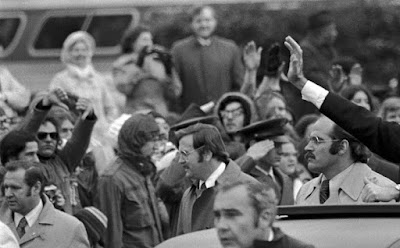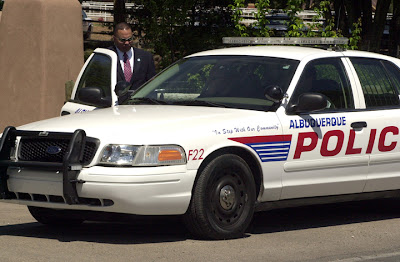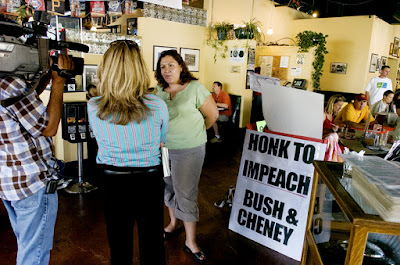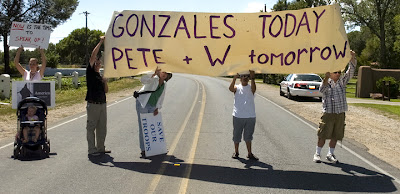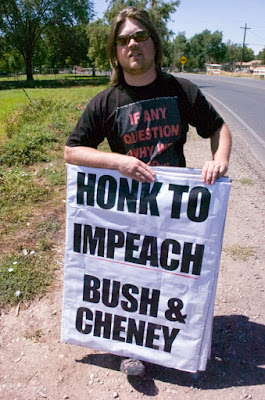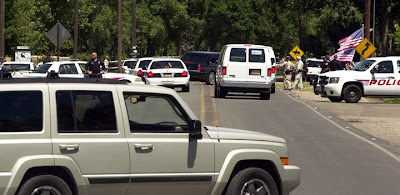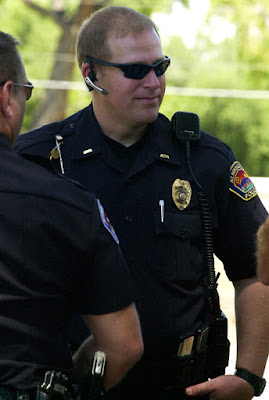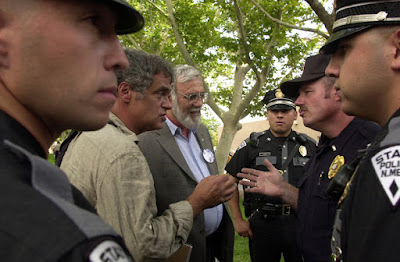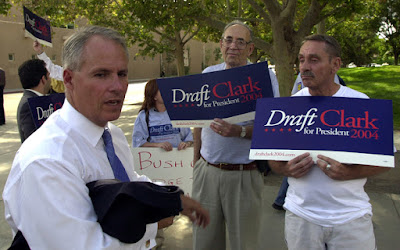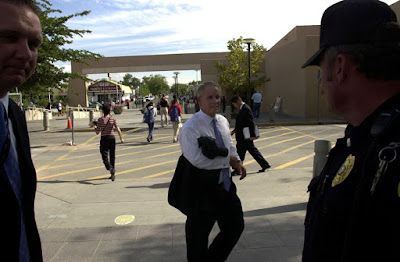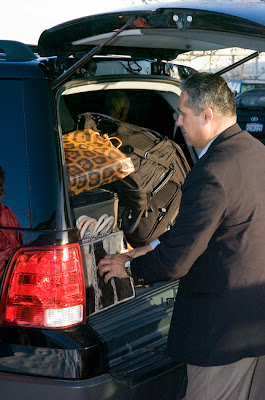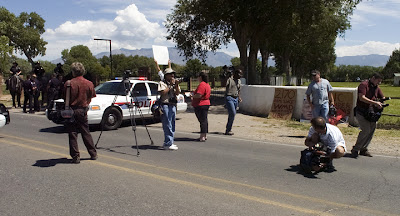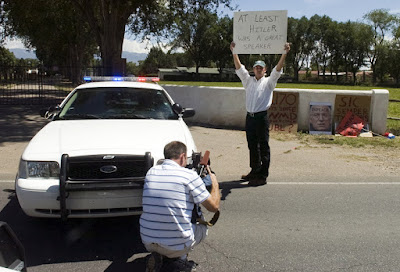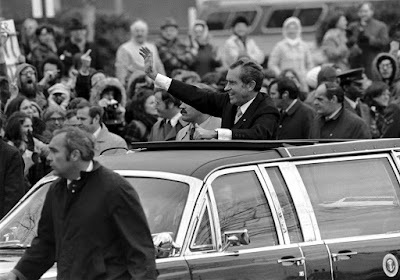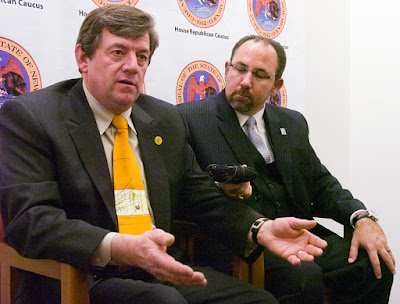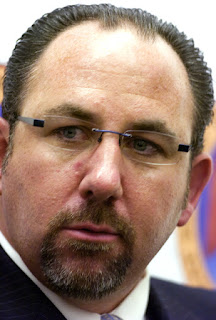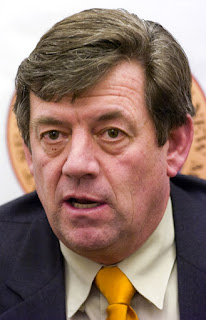“I had wanted to see the first debate…,” my blogger colleague, Mario Burgos, posted.
So did I.
The event was closed to the media by its organizer, former N.M. Rep. Rory Ogle.
 Bernalillo County Sheriff Darren White, left, and State Sen. Joe Carraro, right, are seeking the U.S. House seat vacated by current Rep. Heather Wilson. She is seeking the Senate position of retiring Sen. Pete Domenici. White and Carraro were scheduled to debate before a Republican group in Albuquerque. Blogger Joe Monahan posted that a “no media” rule was in effect.
Bernalillo County Sheriff Darren White, left, and State Sen. Joe Carraro, right, are seeking the U.S. House seat vacated by current Rep. Heather Wilson. She is seeking the Senate position of retiring Sen. Pete Domenici. White and Carraro were scheduled to debate before a Republican group in Albuquerque. Blogger Joe Monahan posted that a “no media” rule was in effect.“Ok, normally I would be the first one to agree that all debates by candidates for public office should be open,” Burgos wrote. “But, here is the thing. According to the meeting organizer, former State Representative Rory Ogle, both candidates agreed to a ‘no press’ rule.”
 Rule? Where does anyone get the idea that they can impose such a rule on a debate for public office? Clearly, not someone who has any regard for: the underpinnings of this country, the political process, a free and open society, or of the party, or the potential electorate.
Rule? Where does anyone get the idea that they can impose such a rule on a debate for public office? Clearly, not someone who has any regard for: the underpinnings of this country, the political process, a free and open society, or of the party, or the potential electorate.All the excuses given for disallowing coverage of a public debate simply fail.
I seldom listen to those who tell me to pick my fights. However, I didn’t run over to the event with my cameras around my neck and my voter registration card in my hand to storm the barricades.
My view was that this was such a political debacle that I didn’t want to be anywhere close to the falling debris. Gravity still works and the thud to the ground would have gotten so much dust on my equipment that I would still be trying to clean it up.
 When Carraro was contemplating announcing his run for the House, a couple of months ago, he told me that he would invite the press, and me to all his events. I didn’t get an invite to this event, or even to his announcement. He also said that he would beat White in any debate on the issues, hands down.
When Carraro was contemplating announcing his run for the House, a couple of months ago, he told me that he would invite the press, and me to all his events. I didn’t get an invite to this event, or even to his announcement. He also said that he would beat White in any debate on the issues, hands down.Is it possible that others, those supporting White, agree with Carraro’s assessment of White’s debating incapability’s, or weakness?
Some suggest that if Carraro did not want to follow this rule, he should have opted out of the debate. Are they manipulating the forum to play a twisted game of hiding the candidates for public office unless you are a member of a new secret political party?
The argument seems to be: come on, everybody else is agreeing to keep the press and therefore, the public, from seeing what the candidates have to say. Was this debate a dry run to see if the candidates can stand up to each other before they take their show on the road?
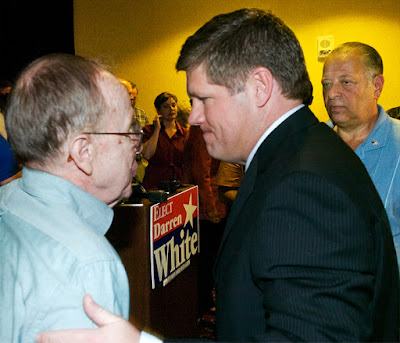
“…Joe Carraro acted like a big mouth asshole when he invited the media & argued his reasoning with the organizer, Rory Ogle,” Alan Leonetti, seen here, right, at White’s announcement, wrote, in a comment on Burgos’ blog. “It just goes to show the rotten big mouth common character of Carraro,” Leonetti went on before signing off, “Republicanly yours.”
What’s Wrong With This Picture?
Debates are tricky events. Republicans are particularly wary. In 1960, former Vice President Richard Nixon squared off against Democratic presidential nominee Sen. John F. Kennedy in a televised debate. Analysis of the day reported that Nixon was better prepared and more knowledgeable on the issues. Polling of people who listened on the radio thought Nixon outscored Kennedy. However, for those who watched on television, the results were drastically different. Nixon had been: ill, he had a heavy five-o’clock shadow, applied his own makeup, and he sweated profusely under the intense studio lights. Kennedy appeared tanned and fit, though we would later learn that his health was poor and a closely guarded secret. The two images swung the TV audience in favor of Kennedy.
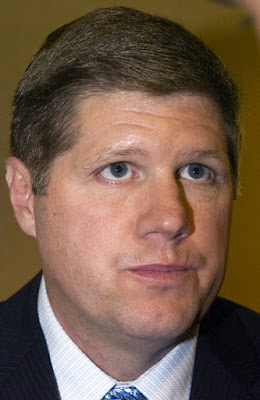
White, at his announcement, October 10, 2007, has Nixon beat in the sweat department. The new TV lights are nothing compared to nearly 50 years ago.
Twenty years later, the Republicans had little to fear with former California Governor Ronald Reagan. During a New Hampshire debate with front-runner George H.W. Bush, Reagan refused to yield the floor to moderator and Editor John Breen of the Nashua Telegraph by saying, "I paid for this microphone, Mr. Green." Reagan had paid for the microphone as part of an event he sponsored because he was unsure if a newspaper-sponsored debate might violate federal election regulations by not allowing the seven-candidate field to participate.
Candidates with strong debating skills want to take on opponents who are not as strong.
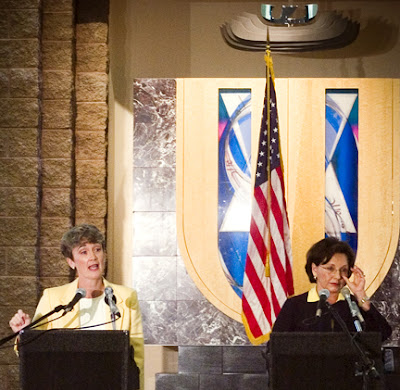 We’ve seen it before. A little over a year ago in the U.S. District 1 race between Wilson and her Democratic opponent, State Attorney General Patricia Madrid, went through a series of debates. The first, at Temple Albert, was not aired live, by agreement. That debate had no clear winner, though both sides spun their candidate’s performances as victories.
We’ve seen it before. A little over a year ago in the U.S. District 1 race between Wilson and her Democratic opponent, State Attorney General Patricia Madrid, went through a series of debates. The first, at Temple Albert, was not aired live, by agreement. That debate had no clear winner, though both sides spun their candidate’s performances as victories.Wilson accused Madrid of avoiding debates, but Wilson cancelled, at least one dual function.
A later live television debate was different as Madrid froze when Wilson asked her a direct question. Wilson won the election by less than 900 votes.
 My Take
My Take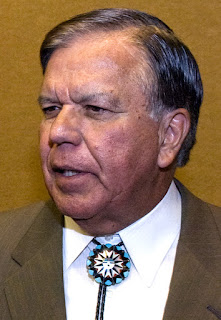 The Republican Party, at one level, still touts itself as having a big tent, open to anyone. Bernalillo County Republican Party Chairman Fernando C. de Baca, right, told me that all Republican events are open to the press. It doesn’t seem like he has any influence in this arena.
The Republican Party, at one level, still touts itself as having a big tent, open to anyone. Bernalillo County Republican Party Chairman Fernando C. de Baca, right, told me that all Republican events are open to the press. It doesn’t seem like he has any influence in this arena.Leonetti’s assertion, that after seeing the closed debate, White was the winner, will be held as nothing more than an avid supporter attacking his candidate’s opponent in an unveiled negative attack.
There is never a wrong time to do the right thing!
So, even if Carraro had initially agreed to the silly "no media” rule, it is not his later complaint that is at issue. Why did those in support of barring the media not recognize such an act sends a clear message, at least for this group of Republicans, they have no respect for our country?
 Ogle, represented Albuquerque’s far-east heights State House Dist. 28 for two years starting in 2003. He was accused in an incident of alleged domestic abuse for throwing a headboard and striking his wife. He was initially charged in July of 2004 with aggravated battery on a household member. He pleaded guilty to an amended charge of battery on the person of another. Ogle’s attorney was former Secretary of corrections Rob Perry, right, at White’s announcement. Ogle was sentenced to six-months of probation. In 2005, fellow Republican Jimmie Hall replaced Ogle in the legislature.
Ogle, represented Albuquerque’s far-east heights State House Dist. 28 for two years starting in 2003. He was accused in an incident of alleged domestic abuse for throwing a headboard and striking his wife. He was initially charged in July of 2004 with aggravated battery on a household member. He pleaded guilty to an amended charge of battery on the person of another. Ogle’s attorney was former Secretary of corrections Rob Perry, right, at White’s announcement. Ogle was sentenced to six-months of probation. In 2005, fellow Republican Jimmie Hall replaced Ogle in the legislature.Ogle, Burgos, who disclosed that he has made a financial political contribution to White’s campaign, and Leonetti, are clearly supporters of White. The event was more about supporting White than it was holding an open and honest debate.
